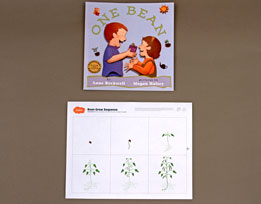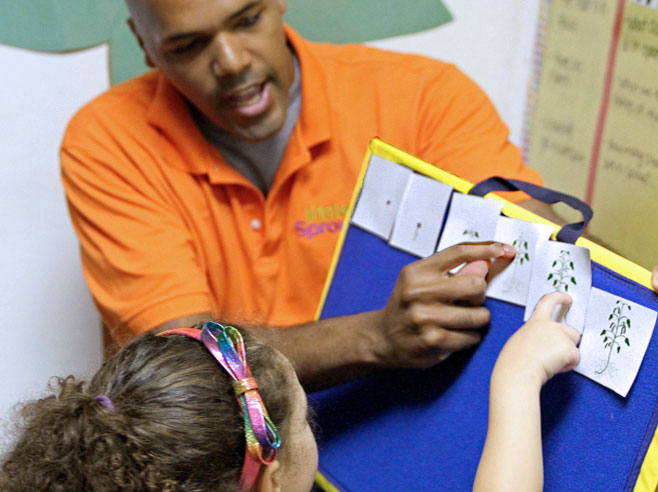Children listen to the book One Bean, by Anne Rockwell, and place pictures of a growing bean plant in sequential order.
Materials

- One Bean by Anne Rockwell
- Bean Growth Sequence Cards (PDF)
- Cardstock or paper (for printing)
- Scissors
- Optional: Magnetic board or flannel board
- Optional: Magnetic tape, Velcro, or felt to glue to the back of the Bean Growth Sequence Cards
Preparation
- Print a copy of the Bean Growth Sequence Cards on cardstock or paper and cut into six cards. Laminate if possible.
- Optional: If you have a magnetic board or flannel board, consider placing a strip of magnetic tape, Velcro, or felt on the back of the cards so that they can be used as magnetic board or flannel board pictures.
- Familiarize yourself with the pictures and text in One Bean and note how the six Bean Growth Sequence Cards match up with the text.
Directions: Lessons 5, 6
Circle Time: Introduction
- Introduce the Bean Growth Sequence Cards. Display the picture sequence cards of a bean plant on a magnetic board, flannel board, or on the rug. Tell children that the pictures show the life of a bean, starting when it is a little seed under the ground and ending when it is a fully grown plant with beans hanging from its branches.
- Ask a volunteer to choose one picture and tell the class about what she or he sees in the picture. Encourage other children to add to that information. Children are building plant vocabulary and concepts as they observe and describe how the plant is changing.
- Repeat with another picture. Have children compare the sequence images and describe how the plant has changed.
- Ask children to look at the little seed and the (small sprout/tall plant). How has the plant changed? How are the image with the flower buds and the image with the beans the same? How are they different?
- Place the sequence pictures of the bean plant in random order at the bottom of the board or on the rug.
- Read One Bean aloud to children. As you read, pause to let children choose the matching sequence pictures and place them in a row in the center of the board. As you pause, use discussion ideas such as:
- Can you find a picture of a sprout poking up from the soil with a bean dangling from the end of it, just like in the book?
- Can you name another plant part in the picture?
- How does the (root) help a plant grow?
- By the end of the book, the sequence pictures will be arranged in the correct order. Discuss how a plant grows and changes. Possible discussion ideas:
- Which picture looks most like the bean plants we are growing right now?
- How did the children in the book, One Bean, take care of their bean plant? How have we been taking care of our bean plants to help them grow?


